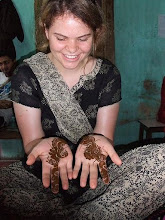Dear dedicated reader,
I am on day three of a five day fast. The purpose of this fast, you ask? To bring me a kind and loving husband, of course. Why else do women fast but for the good of men?
The story behind this five day fast is simple: There was a couple who had been married but had no children, so they prayed to the gods and made personal sacrifices but still no children came. Then, the husband was bitten by a serpent and was near death, so the wife went to the temple and asked the gods, saying how can this happen when we have done so much for you? The gods explained that it was a mistake and that if the woman fasted for five days the health of her husband would be restored. So she fasted, and not only was his health restored, but in a few months she was with child.
I'd been told that all of the female students do this fast and that it is a particular Gujarati tradition, so I agreed to do it with a few (unadmitted) misgivings. The tradition is for all the unmarried girls to do the fast, wear their nicest or newest clothes and most beautiful jewelry and go to temple every morning.
As the uninitiated, I did not have faith that years upon years of cultural tradition would not allow me to waste away. I should have known better. The rules of the fast are this: I cannot eat any salt or any sour thing. Fruit can be eaten throughout the day in small bits to relieve hunger, and wheat may be had once a day, but once I sit down to eat, I cannot get up again until I am finished. If I get up in the middle of the meal, I cannot sit down again and eat, I have finished.
In the words of one of the interns, “This is an Indian fast, Cat; of course they are going to let you eat something.”
The first morning of the fast, Sejalben took us to temple with her. I feel awkward, generally, when I go to temple, even if I like to go. The majority of my temple experiences have been hurried, touristy experiences where a paid guide rushed me through the superficial performing of a puja (worship ceremony) and then at the end asked for a tip. Our visit yesterday morning was different, however, as Sejalben was more than happy to explain the significance of the different parts of the puja.
We arrived at the temple next to the river dedicated to Lord Shiva at 7 am; before the morning rush would happen, Sejalben told us. She is also keeping the fast, despite being married already, for the health of her husband. She brought everything needed: different colored powders, rice, sweet milk, almonds, flowers and strands of long grass picked from the garden.
The temple, overlooking the river, is a peaceful place. We removed our shoes as is customary before entering the temple grounds and made our way to a small house like structure at the far end of the complex. Outside hung a large bell which Sejlaben rang as she entered, the dinging which followed echoing in the silence of the early morning.
Upon entering, we first turned a statue of Ganesh-ji, the Indian god with the head of an elephant. Sejal, Priya and Vanisha rubbed colored powder to his forehead and sprinkled it with water, followed by placing some flowers and some of the long grass atop his head and then touching his feet and their own heads. Melissa and I only watched; I did not feel comfortable enough to do all this myself and without knowing the significance, it would only be a superficial going through the motions as I’d done before anyway.
We moved on to the statue of Lord Shiv, recessed into a backroom of the temple. There was the Shiva Lingam, a large smooth rock over which hung a basin dripping what I assume was sweet milk. I had learned in my Indian Religions class in college that this was a symbol of the balance or beginning of the universe: the lingam, a male force, set in the center of the yoni, the female force. Sejalben, Priya and Vanisha again put together an offering here, going through what I assumed were a ritualized set of steps. Incense was lit and stuck into pieces of whole fruit such as bananas. Sejalben read us the story of the fast in Gujarati and then sang a song while another girl who was also performing the ceremony at this moment joined in and waved a tray with small flames lit across it in circles. Then everyone took a turn pouring some sweet milk which had been brought into the basin at the top and onto the Lingam. The symbolism seemed simple enough for me to decode.
The students seemed fascinated that we are keeping the fast, as are strangers who ask us when we walk around town. I wish I felt more compelled by the knowledge of the ‘why’ behind it; however, I will not give up. It is not so hard, after all: who wouldn't want to eat dessert all day?
Best,
Cat
Subscribe to:
Post Comments (Atom)




No comments:
Post a Comment